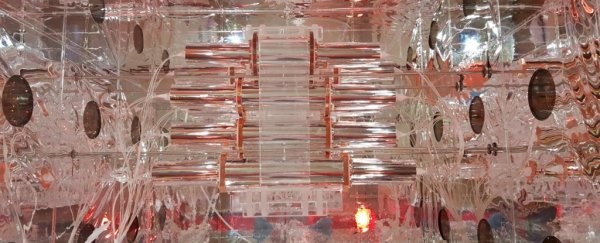Of all the different dark matter detectors in the world, only one has consistently come up with a positive signal. The results of DAMA experiment in Italy are hotly debated - and now two experiments seeking to verify it using the same materials have returned conflicting results.
ANAIS, a dark matter detector run by the University of Zaragoza at the Canfranc Underground Laboratory in Spain, has delivered results that seem to contradict DAMA's.
But COSINE-100, run by a collaboration between the Korea Invisible Mass Search and Yale University at the Yangyang Underground Laboratory in South Korea, has now produced new output. These results are similar to what ANAIS' threw up - but also a little closer to the results DAMA has produced over the last 20 years.
That latest COSINE-100 report also comes after an announcement just a few months ago that the collaboration's results did not support DAMA's dark matter findings.
On top of all that, both experiments are only reporting preliminary results that are yet to be peer reviewed. So, what should we make of all this?
Dark matter is one of the Universe's greatest mysteries. Something is out there generating gravitational force that can't be accounted for by detectable matter. The way the stars and galaxies move indicates that up to 85 percent of the matter in the Universe is actually dark matter.
We have yet to detect it, but it could be producing signatures that we have the ability to detect, if we can refine our technology and know what to look for.
One of these potential signatures is produced by hypothetical 'weakly interacting massive particles,' known as WIMPs. If these particles exist, we should be able to detect them via their collisions with electrons or atomic nuclei, which would cause charged particles on Earth to recoil, producing light that could be picked up by liquid xenon or crystal detectors.
DAMA has been recording WIMP detections since 1995, observed as an annual fluctuation in the number of light flashes detected.
Because of the orbit of Earth around the Sun, and the Solar System's orbit around the galactic centre, Earth should theoretically be exposed to dark matter flux from the galactic halo around peaking at around 2 June and ebbing at around 2 December.
This is because the faster we are moving through space, the more dark matter should pound us, and mid-year is when the orbital speeds of Earth and the Solar System combine.
This is exactly what DAMA scientists claim their results show, but no other dark matter detector has come close to replicating it - not even XENON1T, hailed as our best shot at finding the elusive stuff.
However, XENON1T uses liquid xenon detectors. Meanwhile DAMA uses sodium iodide crystal detectors in a tank filled with liquid scintillator to tag cosmic ray muons, so this is what ANAIS and COSINE-100 used too.
But for all that, we're still in shrug emoji territory.
ANAIS' data did turn up fluctuations, but they weren't in sync with DAMA's June peak and December ebb. And, while the COSINE-100 result was closer than ANAIS', it still "confirms that DAMA's modulation signal cannot be from standard WIMP & [standard halo model] with [sodium iodide]," the researchers said.
So, why are these experiments, all so similar, producing such different results? Is someone doing something wrong? Are slight differences in the detectors to blame? If this plot got any thicker, it would be congealed porridge.
"There is really no conclusion to be drawn at this point, other than mounting suspense," physicist and dark matter Juan Collar of the University of Chicago in Illinois told Nature. "But the instruments seem to have sufficient sensitivity to give conclusive results soon."
It's probably going to take a few more years of observations before physicists are any closer to unveiling the truth. We are waiting with bated breath.
The COSINE-100 results were presented at the Results and Perspectives in Particle Physics conference on 12 March. The ANAIS results have been published on arXiv.
